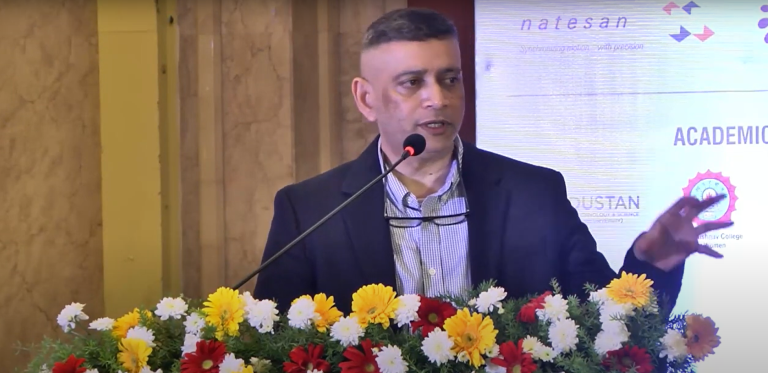Sriram Rajagopal, Founder and Director, of Diamondpick, shared invaluable insights on ‘Developing the World’s Leading Talent Engine‘ at the MMA Annual Convention 2024. Sriram emphasized the importance of talent excellence in India’s evolving workforce landscape. India’s transition to the most populous country globally presents a significant opportunity, requiring a paradigm shift towards skill transformation and education initiatives. With its robust STEM programs and outsourcing dominance, India is poised to lead in talent supply. However, balancing demand and automation necessitates strategic workforce recalibration and reskilling initiatives. Collaboration, government policies, and flexible work models are key to realizing India’s potential as a talent powerhouse. Organizations must evaluate talent strategies, embrace innovative employment models, and prioritize re-skilling to thrive in the future of work.

Sriram Rajagopal, Founder and Director – Diamondpick, took the stage at the MMA Annual Convention 2024 hosted by the Madras Management Association. As part of a distinguished panel led by Anurag Sharma, Associate Partner at McKinsey, Sriram shared invaluable insights on the topic of ‘Developing the World’s Leading Talent Engine’ along with Viswanath P S – CEO, Randstad India, and Padmaja Alaganandan, Head of HR at PwC.
Drawing from his expertise of the talent ecosystem and experiences transitioning from a talent consumer to a supplier, Sriram shares unique insights into building the world’s leading talent engine. Explore the insights into the dynamics of talent development, offering a glimpse into the future of workforce strategy and innovation.
Navigating the Path to Becoming the World's Leading Talent Engine
India has recently replaced China as the most populous country in the world. Its large talent population, burgeoning middle class, robust supply of skilled workers, and resilience amidst global headwinds make it a thriving market for global talent.
India is already positioned to be a leading global talent supplier. It has the second-largest employment pool in the world and is all set to become the largest employment pool by 2047. To be categorized and considered the world’s leading talent pool goes beyond just being a numbers game—it is about building talent excellence.
Beyond the sheer abundance of talent pools, capacity and capability are also two important factors to be considered. With India’s growing population and its potential to emerge as the largest employment pool, there is a need for a paradigm shift in defining talent excellence.
Navigating the Supply Side Dynamics
Delving deeper into the supply-side dynamics elucidates India’s formidable position as a talent powerhouse. With a staggering workforce and a robust STEM graduate program, India stands poised as a beacon of talent potential. However, to elevate India’s stature as a skill superpower, we require a concerted focus on skill transformation initiatives and industry-relevant education.
In the next 5-6 years, India will generate a large part of the world’s global workforce. To become a skill superpower, there are government initiatives with sector skills councils and other schemes that work on skill transformation. Universities, too are offering skill transformation programs. It’s important to evaluate if that is enough to create the world’s leading talent hub or do we need to do more.
From a supply perspective, India has the world’s leading STEM graduate program. The number of skilled talents that come out of these programs is enormous. India is also the world’s leading destination for outsourcing and offshoring. A big advantage is that 60% of the global market share of outsourcing and offshoring is in India. India already has the credibility and needs to capitalize on it to create the world’s leading talent engine.
On the demand side, studies reveal that there will be a workforce demand spike by 2030, and India and China will be the countries that will be able to close that gap. India scores over China on the services side by producing quality talent.
The impact of automation and AI on productivity improvement ranges anywhere between 20-40% depending on the job role. So workforce transformation and re-skilling will be required so that the workforce doesn’t become redundant. A World Economic Forum report mentions an initiative to train about 600 million people across the globe on emerging tech or emerging services just to make sure people don’t become redundant in their workforce.
So while there is demand, additional supply will be generated with automation.

Balancing Demand and Automation
Amidst the rapid acceleration in automation and AI, the demand for talent continues to soar. Technology advancement necessitates a strategic recalibration of workforce dynamics and reskilling initiatives to navigate the evolving contours of the talent landscape.
A collaborative approach towards talent management that includes talent supply cooperation to address the aspirations of the modern workforce is necessary. By fostering a culture of collaboration and innovation, we can envision a future where India emerges as a powerhouse of talent excellence.
What should organizations do?
Large organizations have enterprise risk teams to evaluate the impact of Gen AI. Organizations must create an inventory for current roles and measure the impact of AI or automation or Gen AI in a three to five-year horizon and then decide how to:
- Invest in new talent, or
- Bring in more fungible talent, or
- Move talent between job roles, or
- Understand roles that will become redundant.
Government policies to create re-skilling opportunities, like the National Apprenticeship Promotion Scheme, should be implemented to ensure that talent is trained, re-skilled, or skilled while getting deployed.
Another aspect to factor in is Millennials and Gen Z aspirations. Giving them opportunities that offer job satisfaction and to make more money. Today we frown upon dual employment, moonlighting, gigs, and remote working. Perhaps it’s time to relook at employment contracts for ‘Talent Supply Coopetition’ – competition is where you compete with each other, but ‘Coopetition’ is where you compete and collaborate with each other, a phenomenon seen in product companies that we must emulate for example – Apple and Google are competitors, but they also collaborate, and Apple runs Google’s search engine. In an employment context, there are opportunities to collaborate across commonly hired skills.
There is a need and an aspiration – for organizations who need skilled talent and talent who aspire for opportunities to earn more money. It’s important for us to open up towards these work models to truly be the world’s leading talent engine.
In conclusion, by embracing collaboration, innovation, and flexible work models, India can truly become the world’s leading talent engine, empowering both organizations and individuals to thrive in the future of work.
